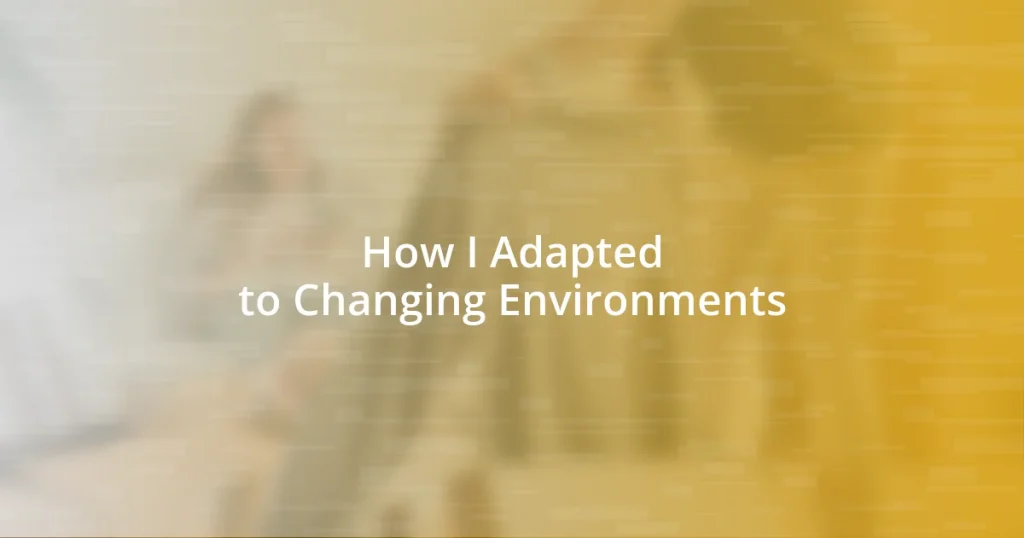Key takeaways:
- Adapting to changing environments requires a flexible mindset, viewing challenges as opportunities for growth and innovation.
- Recognizing signs of change—both in personal and professional settings—enhances adaptability and fosters supportive connections with others.
- Building resilience involves practicing self-compassion, engaging in community support, and learning from past experiences to frame setbacks as valuable lessons.

Understanding changing environments
Understanding changing environments is critical, especially in our fast-paced world. I remember a time when I had to adjust to a new job culture that felt like a complete upheaval of everything I was used to. Can you think of a situation where you faced a similar challenge? It was a lesson in adaptability that stretched my comfort zone, and the emotional turmoil made me realize how important flexibility is.
There’s something invigorating yet intimidating about change, don’t you think? When I moved to a bustling city from a quiet town, the sheer pace of life left me breathless. I often found myself overwhelmed but also surprisingly exhilarated, demonstrating that it’s okay to feel a mix of emotions during transitions—each prompts growth and resilience.
In understanding these environments, we must recognize the nuances of our surroundings. I often ask myself, how can I see this as an opportunity rather than a setback? Shifting my mindset helped me glean valuable lessons from these experiences, ultimately paving the way for personal evolution. It’s fascinating how embracing change can reveal more about who we are.

Recognizing signs of change
Recognizing the signs of change in our environment often feels like being on a rollercoaster, with the ups and downs impacting how we react. For instance, when I started noticing subtle shifts in my colleagues’ moods and communication styles, I realized that a change was brewing within the team. This prompted me to pay closer attention to verbal and non-verbal cues—like body language or shifts in enthusiasm—indicating something was amiss, and it was essential to adapt my approach quickly.
Sometimes, the changes are less obvious and require a more reflective mindset. I recall moments of solitude when I took a step back to assess not just my work life, but my personal life as well. In those quiet reflections, I absorbed the signs of change—family dynamics shifting or friendships evolving—suggesting that adaptability isn’t just a professional skill, but a lifelong journey.
Finally, it’s often helpful to maintain an open dialogue with those around you. I remember reaching out to friends when I sensed an undercurrent of change in our social group. Their insights were invaluable, revealing that changes are often collective experiences, not solitary ones. Recognizing these signals collectively paved the way for a more supportive environment where we could all adjust together.
| Signs of Change | Personal Experience |
|---|---|
| Changes in Communication | Noticed colleagues becoming less engaging. |
| Shifts in Relationships | Reflecting on evolving friendships during transitions. |
| Collective Awareness | Discussing changes with friends for better adaptability. |

Developing flexibility in mindset
Developing flexibility in mindset is about shifting your perspective when faced with new challenges. There was a moment when I was tackling an unexpected project change at work. It caught me off guard and stirred up a wave of panic initially. However, instead of seeing it as a setback, I decided to view it as an opportunity to innovate. This shift in thinking not only eased my anxiety but also sparked creativity, leading me to propose ideas that I never would have considered before.
To cultivate this adaptable mindset, here are a few strategies I found effective:
- Embrace discomfort: I learned that stepping out of my comfort zone often opens doors to unexpected growth.
- Practice gratitude: Reflecting on what I appreciate about change helps me focus on the positives rather than the negatives.
- Stay curious: When faced with new situations, I remind myself to ask questions and learn from them, transforming uncertainty into excitement.
- Adopt a growth mindset: I started viewing mistakes as valuable lessons rather than failures, which helped me bounce back faster.
These small shifts in mindset can yield remarkable results as we navigate through life’s constant transitions.

Implementing adaptive strategies
Implementing adaptive strategies requires a proactive approach. I vividly remember a time when our team was suddenly tasked with adopting a new software tool. Initially, I felt overwhelmed, unsure if I could keep up. Instead of letting that anxiety paralyze me, I adopted a strategy: I broke the learning process into manageable chunks. By dedicating only 30 minutes each day to explore the software, I transformed that initial panic into gradual mastery—an approach that allowed me to support my colleagues along the way.
In another instance, I faced a significant upheaval in my personal life. During this period, I realized the importance of establishing a routine amidst chaos. Setting aside time for exercise and meditation provided me clarity and grounding. It was almost like adding a compass to my shifting sands. I often ask myself, how do we find stability when everything around us feels in flux? By implementing these small, structured habits, I equipped myself with a framework to better handle the emotional turbulence, making adaptability feel less daunting.
Moreover, collaboration often plays a crucial role in the adaptability equation. I recall organizing brainstorming sessions with my teammates when faced with a major project pivot. This collective effort not only produced innovative ideas but also fostered a supportive atmosphere. I found myself thinking, isn’t it fascinating how working together can create resilience? Engaging in open dialogues showcased that adaptability is not a solitary journey; it thrives in connection with others.

Building resilience in adversity
Building resilience in the face of adversity has been a cornerstone of my growth. One particular moment comes to mind: after a devastating setback in a project I was passionate about, I felt utterly disheartened. Instead of dwelling on the disappointment, I took a leap of faith and embraced that challenge as a lesson. This shift empowered me to ask myself, how can I turn this frustration into fuel for the future? Such reflections propelled me to develop a deeper understanding of my strengths and weaknesses, ultimately leading me toward more fulfilling endeavors.
In addition, I’ve discovered that tapping into my support network plays a vital role in building resilience. When I experienced a tumultuous period in my life, friends and family became my lifeline. Engaging in heartfelt conversations opened up pathways for healing that I hadn’t anticipated. I often wonder, how powerful can sharing our vulnerabilities be? Each shared experience forged stronger bonds, reinforcing the idea that resilience thrives not just in isolation but within community. It’s remarkable how opening up can transform pain into collective progress.
As I navigated through these adversities, I also realized the importance of self-compassion. There was a time when I was my harshest critic, but practicing kindness toward myself during tough moments felt revolutionary. I made a conscious effort to cheer myself on, reminding myself that setbacks are part of the learning process. In those challenging hours, I asked myself, what would I tell a friend going through the same struggle? Wouldn’t I encourage them to keep going? This realization has been pivotal in my journey, allowing me to cultivate resilience while embracing the complex emotions that accompany change.

Learning from past experiences
Reflecting on my past experiences has been instrumental in shaping how I adapt to change. I recall a project where, after numerous wrong turns, we pivoted strategies without much warning. It was frustrating, and I questioned my approach. But looking back, I recognized that those missteps were what laid the foundation for our eventual success. I often find myself pondering, what if I hadn’t embraced those mistakes? They taught me flexibility and the importance of bouncing back, concepts that have become part of my toolkit for future challenges.
I also learned the value of emotional intelligence through these experiences. One time, during a team shift I didn’t agree with, I let my feelings dictate my reactions, which only created tension. Reflecting on this, I understood that managing my emotions was key to navigating change effectively. So, I started journaling my thoughts to gain clarity, a practice that transformed my perspective. Have you ever felt overwhelmed by your emotions in a difficult situation? I certainly have, and recognizing them helped me respond more thoughtfully, ultimately enhancing my adaptability.
Additionally, I’ve noticed how community plays a substantial role in learning from past situations. When facing significant life changes, the support from mentors and peers helped frame my experiences positively. Sharing stories in those moments bred resilience, and I realized how each person’s journey had valuable lessons packed within. Isn’t it inspiring how our shared experiences can guide us? I often think about how reaching out for advice during those times not only fostered connection but also illuminated paths I hadn’t considered before.

Maintaining a growth-oriented approach
Maintaining a growth-oriented approach is about framing every experience as a stepping stone for development. I remember a time when I was presented with new responsibilities at work that seemed daunting. Instead of feeling overwhelmed, I chose to view this as an opportunity to expand my skill set. It made me wonder: how often do we underestimate our ability to grow? Each new challenge pushes us beyond our perceived limits, showing us we are more capable than we give ourselves credit for.
One crucial lesson I’ve learned is the importance of embracing a learner’s mindset. There was an instance when I tried leading a team on a project, and we stumbled because of my lack of experience. Initially, I felt embarrassed, but then it struck me—this was my chance to teach myself about leadership and collaboration. I often ask myself, why back away from failure when it can offer such rich learning? Each misstep felt like a valuable lesson I could harness for the future, reinforcing my belief that growth thrives on curiosity and resilience.
Moreover, my journey has shown me that consistency plays a vital role in maintaining growth. I’ve found that setting small, achievable goals creates a sense of accomplishment and encourages continuous improvement. For example, after adapting to a new technology at work, I set aside a few minutes each day to deepen my understanding. I often reflect on the question: how does consistent effort compound over time? The daily wins, no matter how small, gradually build into profound changes, reinforcing the notion that progress is a journey, not a destination.















